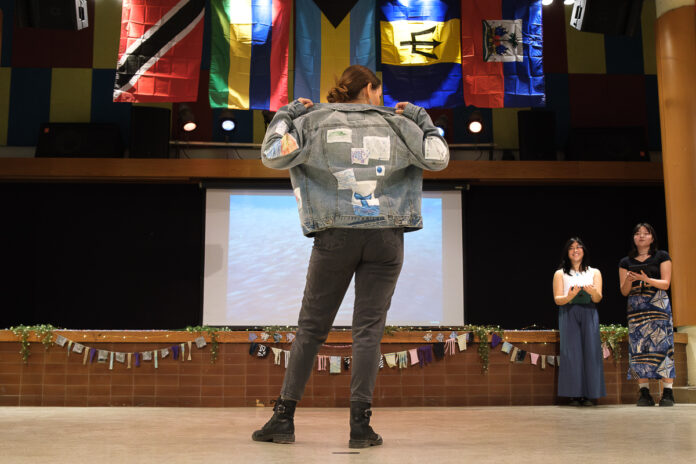
Models strutted down the runway in earthy garments at the student-led environmentalist fashion show Project Waterway on March 12, showcasing the art of sustainability through a diverse array of fashion designs.
Held at the University of Ottawa, Project Waterway focused on consumer conscientiousness in the age of fast fashion, while highlighting students’ role in protecting the Ottawa River.
The catwalk was a joint effort between Unity for Action, the uOttawa Sustainable Development Centre and Ocean Wise, a global conservation organization aiming to protect waterways and oceans.
All designs were created and modelled by uOttawa students, and show sales went to Belong Ottawa, a support organization for marginalized people.
The fashion show’s opening segment, the Beauty of Water, focused on the history and function of the Ottawa River, depicted through pearl satin and colourful embroidery. An immersive, relaxed underwater soundtrack played in the background.
Next, the Anthropocene focused on harmful human environmental impacts, such as oil pollution and overfishing, through stained green clothes and stitched visuals of fish bones. The final segment, the New Wave, urged attendees to be conscious of their clothing and develop eco-friendly habits.
Sophia Arellano, a second-year environmental studies student at uOttawa and co-leader of Project Waterway, said she felt the runway show “would be a cool way to educate people on the impacts of our fashion.”
“I knew I wanted to do something artsy and somehow incorporate environmental themes,” Arellano said. “I landed on the idea of a fashion show because I love upcycling.”
Arellano said Project Waterway was influenced by 2019 research from the Ottawa Riverkeepers, which discovered microfibres along the Ottawa River. Microfibres are a form of microplastics originating from fast-fashion synthetic fabrics, such as ultrasuede and polyesters.
These microfibres can contain toxic chemicals and are challenging to remove from waterways and wastewater treatment systems.
“In all the samples that had microplastics, there was always microfibres,” Arellano said. “It really opened my eyes and it made me realize we need to be more conscious about the clothing that we’re wearing.”
Arellano said she believes promoting fashion sustainability on campuses will encourage students to choose clothing that is safer for Ottawa’s environment. She recommends checking the tags on clothing and avoiding synthetic fabrics.
“The beautiful thing about fashion is that it’s a way of expressing ourselves,” Arellano said. “When we incorporate sustainable practices into fashion […] it makes people realize that fashion doesn’t have to be the next new, flashy, big thing.”
Hana Irwin, a fourth-year communications student and the Unity for Action uOttawa vice-president of marketing, co-led the project alongside Arellano. Irwin said she wanted to promote fashion sustainability.
“[It’s] informing people that fast fashion and the fashion industry is just really damaging,” Irwin said. “We can make a difference on our own by changing our own purchasing habits.”
Irwin said she focused on ensuring Project Waterway was a fun, creative outlet for designers and models.
“I think this is a cool way to show outfits that we put together and made in a sustainable way,” Irwin said.
Sasha Emery, a fourth-year environmental studies student at uOttawa, created and modeled their personal designs for Project Waterway.
For the show, Emery crocheted a top with reused yarn, which was then paired with thrifted clothing.
“The crochet pattern resembles a fishing net,” Emery said. “My vision [was that] I wanted to look like something being stuck in a fishing net. I wanted to recreate that feeling of being trapped.”
Emery said the show allowed them to express their passion for environmental activism through their craft. They added they hope Project Waterway draws attention to excessive clothing consumption.
“I have always loved design and fashion but I just never really allowed myself time to explore these [passions],” Emery said. “Maybe this form of art, making clothes, is also part of the sustainability movement.”
Featured image by Owen Spillios-Hunter/the Charlatan.





